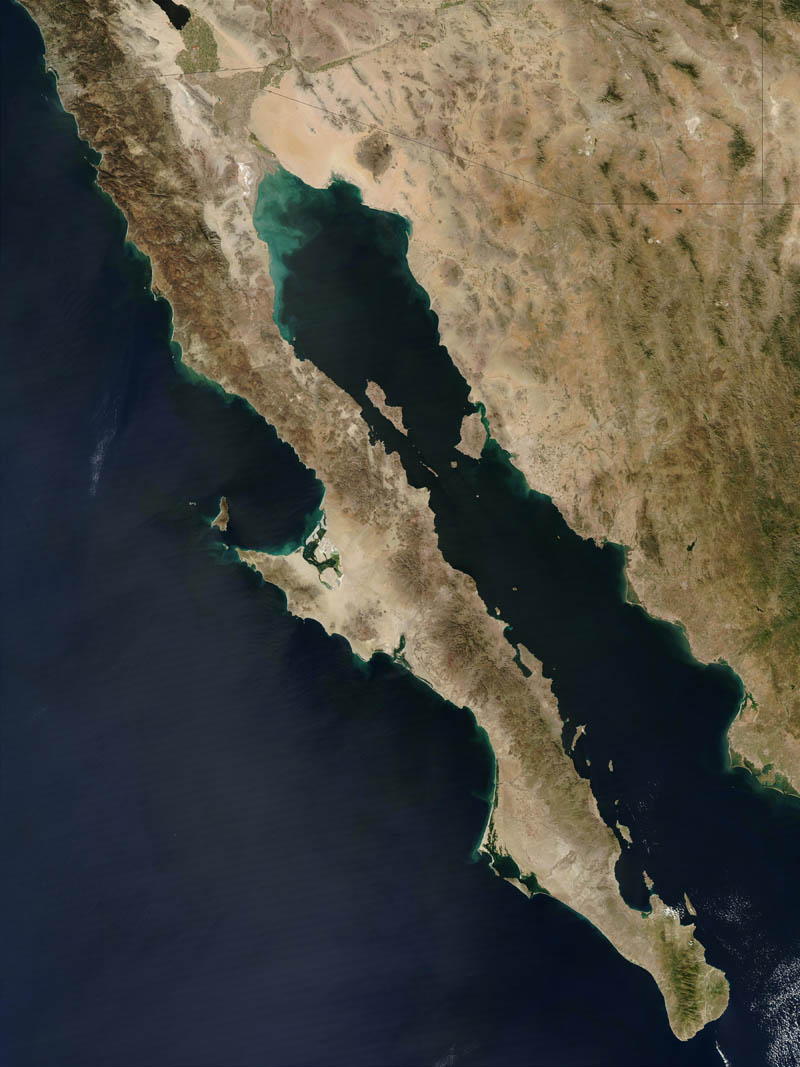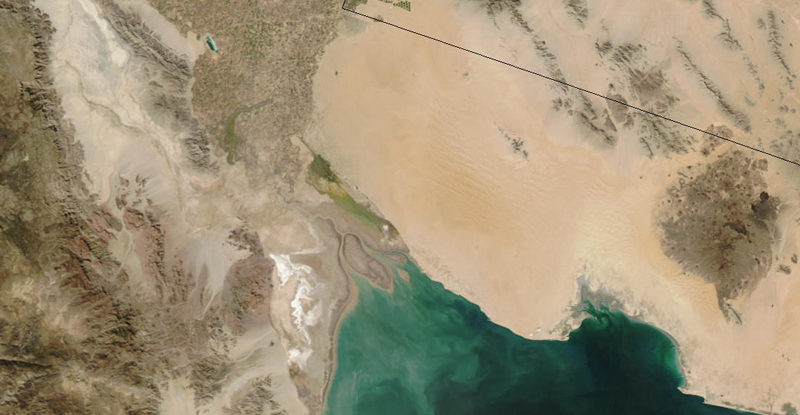Altar Desert Adventure
Altar Dunes, Mar de Cortez and Guadalupe Canyon
20090131 to 20090207
Back to Bill Caid's Home Page.

Sunset over the Sea of Cortez illuminates mountains in Baja.
Canon 1DsM3, 300mm, 1/320 at f/6.3 ISO 100. All photos copyright, Bill Caid 2009. All rights reserved.
Another Great Trip with Friends
Northwestern Sonora in Mexico is one of the largest remaining remote areas south of Canada. This area is hard core desert, cruel in the summer and unforgiving of mistakes. Four wheel drive clubs in the southwest have been making crossings of the Altar Dunes from Sonoyta and San Luis del Colorado for many years. This vast area offers one of the last remaining true adventures within easy driving distance from the US. This group has done this trip in 2000, 2002, 2003, 2004, 2005, 2007 with nearly the same crew, so we had good knowledge of the rigors that faced us. Plus, had done "mini-trips" in 2008 so we had recent information about conditions. Indeed, the Altar is a test of man and machine as well as your logistical planning skills.
The Team
The away team for this trip consisted of 7 vehicles and 14 people, all (reasonably) seasoned travelers:
-
Bill and Kathleen from San Diego, CA in Bill's Unimog 1300L with recently added Alaska Camper.
-
Kai from San Diego, CA in his Unimog 416 DOKA.
-
Matt and Nancy from La Crecenta in their Unimog 416.
-
Dan from Fairbanks, AK and his buddy Robert from Fairbanks, AK in Dan's Unimog 1550L.
-
Mark and his son Russ from San Diego in Mark's Unimog 1300L.
-
Roberto from San Diego and his buddy Juan Carlos from Celaya, MX riding as passengers in Richard's G-wagon.
-
Richard from Rancho Santa Fe in his Mereceds G-wagon.
-
Sean and Steve from Oakwood, GA as ride-alongs.
The Preparation
Any trip to the Altar desert requires much forethought and planning. The group had been discussing a trip for some months before the actual date was decided. For this trip, we had a number of folks traveling from distant places to attend. This alone required planning, but additionally, machines and kit must be prepared as well. Kathleen and I had finished an 8,000 mile trip in our 1300L a few months prior to this trip. But, a trip of that length usually takes a toll on the equipment. That trip was no exception. Specifically, there was a set of repair actions that I had to perform on the truck that included replacing parking brakes, disc brake seals and dust boots. Additionally, the 8,000 mile trip, which was mostly on the highway wore my tires down to the carcass. Kathleen and I dismounted and re-mounted 5 XM-47 tires to prepare for the trip. Tons of work, but you MUST have the right tires that are capable of operating at low air pressure to consider a trip to the high dunes of the Altar desert. And, this trip re-proved that assertion.
In addition to the normal mechanical repair and inspection, we had added an Alaskan Camper (see installation report). To insure that we had a trouble-free trip, that needed some maintenance and lovin' as well. The camper is 30 years old and things fail, even if they were new. More so if the equipment is old.
Roberto Espinoza had been planning for this trip for some time. His 1450 DOKA was being worked on in his home town of Celaya, MX. To get "staged" for the trip, Roberto had to fly to Celaya and drive all the way back to San Diego. On 20090126, nearly back to San Diego, he suffered an engine failure requiring a tow to a Mercedes truck shop in Mexicali, MX. His truck did not make it this trip; he and his buddy Juan Carlos rode as passengers in Richard's G-wagon.
The Trip
Our trip to Mexico involved 7 days and around 500 miles of travel. During this trip we would see only a small portion of Mexican Hwy 2 that generally parallels the US border. The plan was to cross the border at Mexicali then drive east on Hwy 2 to the northern entrance of Los Pinacates at Cesar's loncheria, then travel south to El Golfo. From El Golfo, we would head east to camp on the bluffs above the beach and then return through El Golfo. From El Golfo, we would travel north again through the dunes. Upon exit from the dunes near Cesar's, we would head west on Hwy 2 to Laguna Salada, then south to Guadalupe Canyon. From Guadalupe, we would return to the U.S. on Hwy 2 and cross the border at Tecate.
The weather, in general, was kind to us and we had a great trip.
Geography of the Altar Desert
In Figure 1, San Diego bay is just below the top edge on the left. The large lake is the Salton Sea. Farmed areas are shown in darker colors.

Figure 1. Satellite Photo of Baja and Northwest Sonora, Mexico.
In Figure 2, the large dunes are evident and can be seen as forming a set that roughly parallel the coast to the south. The first destination was the east side of the Los Pinacates region which is the dark brown area at the right of Figure 2. We would end up at Guadalupe Canyon which is the northern-most large canyon area on the mountain front on the left of Figure 2.
Figure 2. Zoom Photograph of Area of Interest.
Trip Details
| Day | Date | Adventure |
|---|---|---|
1 |
20090131 |
San Diego to Camp Chili Verde |
2 |
20090201 |
Chili Verde to Camp Mole |
3 |
20090202 |
Camp Mole to Camp Bratwurst |
4 |
20090203 |
Camp Mariscos to Camp Mariscos (Campo Rogelio) |
5 |
20090204 |
Camp Bratwurst to Camp Asado |
6 |
20090205 |
Camp Asado to Camp Lamb Stew |
7 |
20090206 |
Camp Lamb Stew to Guadalupe Canyon |
8 |
20090207 |
Guadalupe Canyon to the United States |
Conclusion
El Golfo is a very small town; it is primarily a fishing village, but does cater to tourists, particularly Gringos around Thanksgiving, Christmas and New Years. There is a Pemex station, and it might have gas and diesel. I say "might", because in Mexico, if the fuel truck does not show up for what ever reason, then there will be no gas or diesel. On this trip, the Pemex station was fully stocked and there were no issues getting fuel. But that has been the exception rather than the rule. El Golfo has a store and ice is available along with plenty of fresh fish, shrimp, clams and sometimes other shellfish. Water is in short supply, but can be purchased at the town OXXO store and other locations. There are several RV parks in town and several "hotels". The quotes are used here since one of the selling features of the hotel is that it has indoor plumbing. That said, since the road to Puerto Penasco has been completed, there has been a lot of construction going on in El Golfo and I am sure that new hotels will be built shortly.
The locals make their living as fishermen and good seafood is available at all times. The best restaurant in El Gulfo is the El Delfin and has excellent food although modest accommodations (they did, however, have hot water in the washroom and fully functional toilets). I highly recommend the chili rellenos and the pescado frito entero (whole fried fish).
Traveler's Advice
Having made many trips into Mexico, every one is different and this one was no exception. Preparation and planning are critical for both having a good time as well as returning with your vehicle and person intact. Many obstacles exist on the roads in Mexico. I cannot count the number of flats that I have had, but I can say that there have been multiple occasions when I have had 2 flats at the same time. So, you need to be prepared to change flats yourself. Even if you were in an area where there was cell phone service, and that is rare, the auto club will offer no help. And, as we learned, your cell phone may not work in Mexico. Be self sufficient. And be cautious. Roads and bridges are narrow. Cattle and other livestock are on the road. Locals may drive vehicles without brake lights, or in some cases headlights, at night.
You will need liability insurance when you cross the border. It is not expensive, but the cost of not having it if you are in an accident will be very expensive. They will toss you in jail and the final outcome will be dependent on how much money you are willing to throw at the problem. Independent of insurance, accidents are best avoided, so drive within the limits of your skill and the conditions on the road. Seems like simple advice, but having been there many times, sometimes simple advice is not simple.
One final note: you will need both a Plan B and an evacuation contingency should someone get sick or injured. Depending on the specific location, you may have extreme difficulty in establishing contact with the US with either land lines or cell phones. Our cell phones, while electronically functional, had spotty coverage and the specific capabilities of your phone and service plan will determine whether you are able to make a call. Should you expect that there might be issues during your trip, you should add Mexico to your calling plan or rent a satellite phone. Otherwise, you may be unpleasantly surprised should you need to communicate.
Miscellaneous Information
Firearms are prohibited in Mexico. Handguns, in particular, are frowned upon. If you are caught with one in your possession, you will go directly to jail. There is a very high likelihood that you will be unable to "buy" your way out of the situation no matter how much money you have with you, so this situation is better avoided. While lack of a firearm in the wilderness will place you at somewhat of a disadvantage should trouble arise, the penalty for possession is so harsh that it is not worth the risk. Northern Sonora and Baja are areas of operations known to be used by drug smugglers. However, open desert crossings are not the preferred route, so the chance of encountering anyone is pretty remote. Although, we have had the Army follow us into the dunes. The Mexican Army does patrol both the north end and the sea-side of the desert as well as the dry lake beds and if they stop you, they will most likely do a thorough search of the vehicle. They pose no threat to honest Gringos that do not break the laws of their country.
Back to Bill Caid's Home Page.
Copyright Bill Caid 2009
